#henry vii x elizabeth of york
Text
How do I say I don't ship Henry VII and Elizabeth of York in a 'they had a perfect relationship' way but in a 'their lives were closely intertwined from the very beginning, marriage was always an option more or less likely on the horizon for them, people had speculated on their union since they were mere children, there was never going to be anyone else really, they would always have to learn to accommodate each other, their shared grave was built before they were born, no one else was going to fit inside their tomb, they lived together so they could die together, they were each other's fate' kind of way.
62 notes
·
View notes
Text
One of the creepier historical myths, and one often used as an appeal to authority by creepy sex predator types, is the idea that premodern history was chock full of adult men boning little girls with the full acceptance and applause of secular and religious authorities.
Luckily, through the broad scope of human cultures and time periods, this just is not true. While it absolutely *happened*, same way it does now across the world (looking at you, US States where legislators calling trans people “groomers” for not wanting trans kids forced into suicide by gender dysphoria are doubling down on keeping ages of consent of *12* and *13*) it was vanishingly rare amongst the vast majority of the population from at least the early medieval period onwards (parts of the classical world were disturbingly big on adult men having sex with pubescent people read as boys and girls), and tended to result in enormous general opprobrium when it did happen.
Marriage before around age 16 minimum is almost entirely a noble phenomenon in the vast majority of history for alliance reasons, and even then cohabitation (ie regular sex - there was in theory ritual “bedding” on the wedding night but it was rarely expected to result in actual p-in-v for people below the age of 16ish) was a thing parents thought *hard* about the timing of because having regular sex with the likelihood of conception was thought to be bad for the health of *both* partners.
If you pick Henry VIII, for example, one of the figures your mind leaps right to when the terms “early modern” and “marriage” are mentioned in close proximity, the excuse that he finally settled on to try to divorce Catherine of Aragon in the end was her brief marriage to his elder brother, Arthur, at that time the heir to the English throne until his early death of what was thought to be sweating sickness. It was accepted for decades of Catherine and Henry’s married life that that marriage was unconsummated without demur because they were both 15 at the time, and despite being ritually bedded (and Arthur making a few comments to his mates the next day about “being in the midst of Spain all night being thirsty work” which Henry’s lawyers made a *lot* of at his direction) they were actively kept away from each other at that point because Arthur’s health wasn’t great and his parents, Henry VII and Elizabeth of York, worried that regular sex at that age would basically drain his energy and unbalance his humours. There was a legal (and sometimes general) assumption in this period that putting a married couple in any kind of proximity where there was even a chance of privacyish meant boning and babies, so those couples married at that age sadly didn’t always get a great chance to get any kind of comfortable with each other even if they were living in the same household.
There is significant literature written in the medieval and early modern periods by clerics *and* medics about the dangers of sex and procreation for immature bodies. It is a topic that’s significantly raised by clerics writing about the need for female consent in marriage, mostly in the earlier medieval period when Christianity had an uneven hold on a lot of Europe, but up to the high medieval period when discussing parents marrying kids off too early for power consolidation; there were always parents who pushed for consummation too early because a marriage could be annulled if consummation couldn’t be proven, but that was rightly regarded as shitty behaviour - wilful endangerment of one’s children’s health or indeed their life for power.
#early modern history#medieval#early medieval#history#consent#historical marriage#the tudor dynasty#the tudors#age of consent#henry vii x elizabeth of york#henry viii#catherine of aragon#historical medicine#historiography
52 notes
·
View notes
Link
Chapters: 1/1
Fandom: The Shadow of the Tower
Rating: General Audiences
Warnings: No Archive Warnings Apply
Relationships: Elizabeth of York Queen of England/Henry VII of England
Characters: Henry VII of England, Margaret Beaufort Countess of Richmond and Derby, Elizabeth of York Queen of England
Additional Tags: Trust Issues, Angst, References to Canonical Illness, Hurt/Comfort
Summary:
The queen shares a bed with her king, and she is cold.
#fanfic#yuletide#gift fic#recs#the shadow of the tower#sott#henry vii x elizabeth of york#henry vii#elizabeth of york#my gift this year!!#it's lovely#<3#author: ????#(it is an anonymous exchange till new year)
6 notes
·
View notes
Text

1/? tudor aesthetics:
⎯ henry vii and elizabeth of york
#gonna post some of my picspams here#historical figure aesthetic#edit#historical edit#history aesthetic#aesthetic#perioddramaedit#*my edits#the white princess#twpedit#henry vii#elizabeth of york#henry x lizzie#jodie comer#jacob collins levy#otp: the welsh dragon and the english rose#tudor aesthetic#tudor era#picspam
117 notes
·
View notes
Note
Hola can you do yandere Parents King henry vii and Elizabeth of York
(Also is its fine if I request the same thing again???)
It's okay to ask the same questions.
You are the favorite child of King Henry vii and Elizabeth of York. They both seem to adore you. They love their other children too, but not as much as they love you. They are ready to fight for you until their last breath. You have the most beautiful dresses and expensive jewellery. They invite the most talented teachers to the Palace for you. When he gets sick and injured, they both panic and get upset. They are overprotective of you. Especially when they lose a few other children, their paranoia increases. They always postpone your marriage issue. They don't allow you to leave the palace much. There are always strong guards around you. They don't even let the nobles get too close to you. After died Elizabeth, the King is getting more paranoid about your life. He is very afraid that something will happen to you.
#yandere tudors characters#yandere the tudors#yandere tudors#house of tudor#the tudors#king henry vii#yandere king henry vii x reader#yandere king henry vii#yandere elizabeth of york#yandere elizabeth of york x reader#yandere the white princess
35 notes
·
View notes
Text
Anyone who has watched The White Queen/Princess series I am considering to write a book x reader for it. If anyone is interested let me know and I will post it once I possibly start writing it ❤️
#possible fanfic idea#possible fic idea?#henry tudor x reader#henry vii of england#henry viii#henry vii x reader#henry tudor#the white queen#the white princess#the war of the roses#jacob collins levy#elizabeth of york#elizabeth woodville#comments really appreciated
29 notes
·
View notes
Text

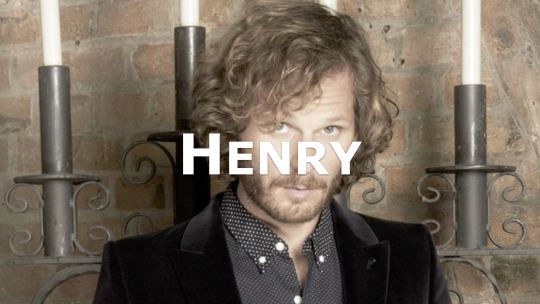
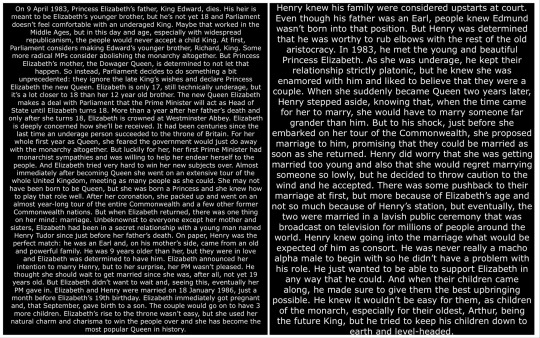

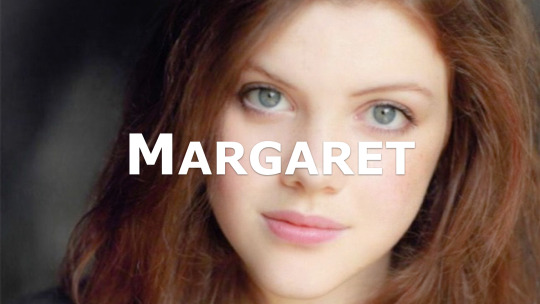

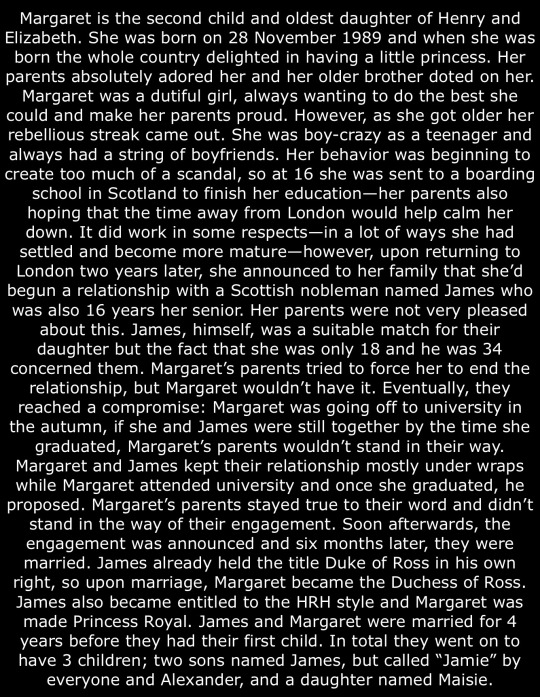


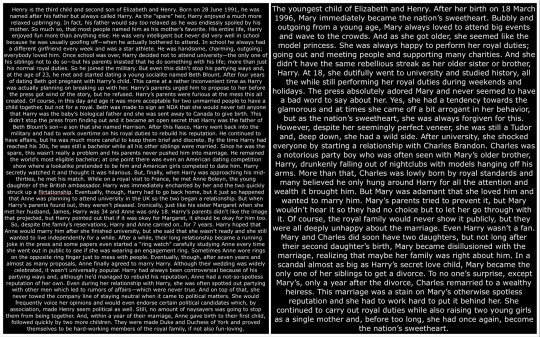
AU: Modern Tudor family.
#i usually try to prioritize reqs over my own stuff#but i haven’t done one in a while and i really just wanted to get one out#mine#au#tudor au#modern au#elizabeth of york#henry vii#arthur prince of wales#margaret tudor#henry viii#mary tudor#henry x elizabeth#arthur x catherine#james x margaret#henry x anne#charles x mary
25 notes
·
View notes
Note
Given Bran doesn't interact with many girls his age I like crackshipping him with characters.
Bran/Shireen would be cute, Bran/Myrcella being romeo/juliet in an AU where bran goes to KL, Bran/Lyanna Mormont seems the most likely to interact given the mormonts will likely flee bear island for winterfell when the others come.
Bran with one of the younger sand snakes like obella would be cute also bran and gwyneth yronwood would be sweet.
Bran's crack ships are so valid! He deserves all the love, my sweet boy ❤️
Bran X Myrcella is my favourite because of the Romeo X Juliet vibes with the rivalry of Starks and Lannisters. Also it could work as the Henry VII x Elizabeth of York at the end of the War of Roses.
Bran X Shireen because both are cuties and they would love reading stories to each other.
Bran x Lyanna Mormont with the girl being so loyal to House Stark she will appreciate Bran as the heir of his House. Plus, she has also served as the head of the family while her mother and sisters where away. So, they have that in common.
Bran x Obella or any other of the younger sand snakes would be cute, too. Dorne and North are so different so they could learn so many things from each other.
Bran x Gwyneth could work better than her and Quentin because at least Bran is around her age.
Also, Bran x Tommen has the same potential with Bran x Myrcella. Tommen is also a sweetheart. And Summer could befriend Ser Pounce.
( tagging my friend @docpiplup who also appreciates Bran's ships)
#bran stark#asoiaf ask#a post of ice and fire#valyrianscrolls#myrcella baratheon#shireen baratheon#lyanna mormont#obella sand#gwyneth yvonwood
19 notes
·
View notes
Text
Meynnart Wewyck’s workshop-part 1-proven paintings
Meynnart Wewyck has for long been hidden in shadow of Hans Holbein the Younger. Everybody knows Holbein’s work, but very few of us know of Meynnart’s work. Even though he was working for Tudors in between 1502-1525. For 23 years! Holbein only for 11 years had royal patronage.
So how come we only have 6 confirmed portraits by Meynnart Wewyck?
It’s complicated. Because most likely Wewyck didn’t work alone. He probably was a master overlooking workshop of artists(painters)-yet only he would be on royal records as the one who would be paid. Work of same workshop can be difficult to identify as painters could come and go(or be sick when certain stage of painting needed to be finished) the resulting work from same workshop could be very different. Their skillset varied, the brushstrokes varried. Depending on turnover of painters-this can be nightmare to try to identify.
Even with all the perks of modern technology. And in case of Meynnart Wewyck’s work, it might be even more complicated. Because yes, dendrology(testing of the wood to determine painting’s age) is helpful, but might not be a deal-breaker when it comes to workshops. Which will sound crazy at first, as you’ll read this, so read entire thing.
Currently I know of 6 paintings which are identified as Meynnart’s work-and experts have no doubt about it.

1.Posthumous portrait of Lady Margaret Beaufort, comissioned in c.1510,
180 x 122 cm , location: the Master's Lodge, St John’s College, Cambridge, UK
2.Portrait of Henry VII, 38 x24.5 cm, location: Society of Antiquaries of London: Burlighton House, UK
3.Portrait of Henry VIII, location: Denver Art Museum, USA, supposedly ca. 1509
4.Portrait of Henry VIII, 44,5 x 29,8 cm location: Anglesey Abbey(National Trust Collection), UK. Supposedly ca 1515 - 1520
5.Portrait of Henry VIII, location: Private collection, supposedly ca 1519
6. Portrait of Henry VIII, location: Private collection, supposedly ca 1513
Why did I put number 4 there twice and crossed one? Because the Henry VIII we look at is not the original. There is painting beneath(which I presume to be Henry too):
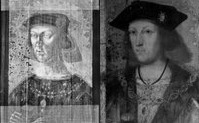
How could they then possibly know this one is by same artists? Well, the cloth of gold has same pattern as in 5 and 6-but imo they didn’t come to that conclusion based upon painting we can see. But due to exhamining all of the painting, not just visual exterior.

Bit of background on the research done by professionals, which I aplaud:
Before 2019, no painting was 100% identified as by Meynnart. Then research into lady Margaret’s painting(1) has been proven to be an original work by Wewyck. They also found evidence that it belonged to John Fisher, Bishop of Rochester and probably never was in hands of Henry VIII.
(So presumably he had some other painting of her, perhaps the 1506 one.)
We can contribute this confirmation to art historians Dr Charlotte Bolland of the National Gallery, London and Dr Andrew Chen of St John's College, Cambridge.
They published their research in the April 2019 issue of Burlighton Magazine. Based on their work with the portrait of Lady Margaret Beaufort, they also attributed a stylistically and structurally similar portrait of one portrait of Henry VII(2) to Wewyck.
Based upon identifying this one, very quicky, still in 2019, a group of specialists from the Yale Center for British Art, with support from the National Portrait Gallery, London and the Hamilton Kerr Institute Cambridge, initiated a research project at the Denvert Art Museum. (Lots of different institutions doing combined research.)
They found 5 paintings painted on wood from same tree. Henry VII(2) and 4 portraits of Henry VIII (3,4,5,6) were painted on that wood.
And according to some sources also they laso identified 2 portraits of Elizabeth of York. While they studied it, and it was part of their project. But ‘being fairly certain’ they are tributable to Wewyck’ is not same as being certain.
What is madening to me, is that I went to websites of all those institutions, searched on interenet for weeks-and yet I cannot find any detailed report about this 2nd project! I have no real idea what they found! I give up. I can’t find it.
Just know only few tidbits about number 4 and then I found out on Denvert Art Museum short article-which deals with few more tidbits. But that is it. And it irritates me to no end that I don’t have more about this!
I’d really love to know what the actual findings were.
It took me ages to even find out which paintings they meant(those in private collections-those were the problem). After going through several articles and ending up empty handed each time(about those in private collection), eventually I found them on this webpage:
https://web.archive.org/web/20200603202704/http://damscout.squarespace.com/comparisons The link for it was actually on wikipedia the whole time!
And I know they found way more. I know it. There are at least 6 different methods they use! Here they are:
DENDROCHRONOLOGY & PANEL EXAMINATION
Deals with exhamining the wood of frame or wooden pannel painting is painted upon. Not all paintings are done on wooden pannels, some are on canvases only, and you can only hope the frame is original.
PIGMENT AND MEDIA ANALYSIS
This is very important because certain painters could always use same pigment mixture or varnish mixture, or glue etc. Or pigments in painting have changed colour, and you need to prove it.
MICROSCOPIC EXAMINATION
This is crucial in order to know artist technique and to determine if it is by same hand. Very HD image can be also be used for it(I use them as amateur). It’s especially great to use if you have two paintings and wish to compare how the painter did the details.
The other 3 methods all deal with allowing us to see beneath the layers of the paint. Like different filters:
INFRA-RED REFLECTOGRAPHY
Particularly good to see the original sketches/drawing-which is likely to be done from life. (and hence to realise if painting wasn’t altered)
X-RAY EXAMINATION
Tbh, I don’t really understand in what way it is different from Infra-red, other that than you can see different layer. It just reveals some details better.
ULTRA VIOLET EXAMINATION
Another method to see what we can’t with naked eye. This one I know what it is for-it reveals overpaint on the painting. Even minor retouching can be seen with this.
Denvert Art Museum on September 1st 2019, posted a short article and it, it credits the people, who did this expert analysis:
Ian Tyers, dendrochronologist, who undertook the dendro on the five linked portraits;
Pam Skiles, senior paintings conservator at the DAM, who facilitated the examination and did the initial infrared examination;
Natalie Feinberg Lopez, architectural conservator, who was contracted in to do the XRF analysis;
Kathleen Stuart, former Berger Collection curator,
and then the author of the article: Christine Slottved Kimbriel, Paintings conservator (of Cambridge University’s Hamilton Kerr Institute in the United Kingdom).
She mentions in the article exhamining the picture under the microscope, analyzying the paint using a technique called x-ray fluorescence spectroscopy and taking tiny paint samples for chemical analysis back in the lab in Cambridge.
And also, working together with an imaging specialist using infrared reflectography to reveal images of what lay beneath the top paint layer.
All methods are nice, but here is what they found. Denvert Art Museum’s portrait of Henry VIII originally had blue background. And it wasn’t only painting in that project, where blue background was revealed. 3/4 had it. Which? Idk. They exhamined 1 of Henry VII and 3 of Henry VIII in Denvert Art Museum. I can only be sure of number 3. Out of 5 paintings, 1 had blue background, 4 had green-and of those 3 turned out to be originally blue.
Furthermore they found traces of gold and paint frame of number 3, which made them believe originally its frame and edge was once decorated as number 2 was:
with golden motive above above the sitter, and red trim and green-and-white striped “barber’s pole” trim:
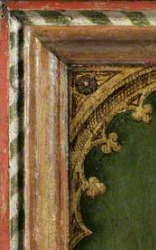
But back to dendrology. So, numbers 2-6 are all done on wooden pannels cut from same tree. 5 paintings painted on wood of same baltic oak, which was felled between 1500-1515. Which gives us date cca 1500-1520, when these were used-according to proffesionals.
(It is presumed that is when they should be used. Imo it should be stretched to 1500-1525 at least.)
Lady Margaret’s posthumous portrait is made out of wood of two baltic oaks(different ones than the remaining 5 paintings), and testing shows one oak was felled after c.1487 and the other after c.1489. So timeframe for these two oaks to be cut and used is ca 1490-1510.
So it is possible that oak was cut 10 or even 20 years before it was used.
Why would they wait so long before using it? Excellent question.
I believe I might know the answer. I heard of practise certain monasteries allegedly did. They would leave cut tree trunks intended to be used for roofs in forest for several years. If nothing touched them(no bug started to eat it, etc.) until certain time was over, then they’d use the wood. Because then it was way less likely that any woodworm would attack the wood later on. Hence insuring the quality. Such wood would last.
If the painters also prefered older untouched wood, it’d explain it. They’d buy one such tree trunk(or part of it) from reliable source and then use it all, over course of many years.
So the dendrology analysis is helpful, in letting us know the paintings are early 16th century works and very likely same workshop, but there is a big issue.
Except lady Margaret’s portrait-where we know portrait’s history, we cannot be sure if the painting is original or very early copy.
Even knowing that some portraits originally had blue background(number 6 still does), and green damask background is alteration in some of them-the traces of blue found, are not conclusive proof that it is an original painting from life.
Because we have portrait of clearly young adult Henry VIII(number 6) with this blue background-suggesting it was still popular at least in 1st half of 1510s.
(Then in mid 1510s in my opinion green damask background took on and continued to be popular up to late 1520s(for half-lenght portraits, miniatures from mid 1520s have ultramarine blue backgrounds).)
If for example young King Henry decided in 1510 to have posthumous portrait of his father made(and we know Henry VIII loved to have posthumous portraits of his relatives), it’d still have the blue background. Dendrology would still fit, the artist/workshop would be the same. If this is the case-how on earth as an expert do you determine if it is an original? I don’t see how. Unless there is some alteration in costume or if you have some proof that artist(s) in this timeframe did something differently.
But for that you’d need to identify a more of paintings by this workshop.
But we’re long way from that still. But we know Wewyck’s workshop certainly made more paintings, that is clear from records. He appears in them as Dutchman, Flemish or Netherlandish-a region known for its artists.
There was no universal spelling back then, so there is at least 15 different ways his name was spelled like, and in Scottland he was even refered to as an English painter called Mynour, instead of a painter in service of English King.
Scotland is actually where he starts in records. In September 1502, Meynnart Wewyck delivered 4 paintings to King James IV of Scotland.
Those paintings were of King Henry VII, Queen Elizabeth of York, Princess Margaret(James’ bethrohed) and Prince Harry(future Henry VIII).
Why no prince Arthur? Because he died in April that year.
Why no princess Mary(Future Queen of France)? Because she was child of 6 and of no importance to Scottish King, unlike Margaret or young Harry.
So prior to September 1502, Wewyck was already in service of English royals.
He then appears to have stayed in Scotland up to November 1503.
Records show he made portraits of James and his bride in 1503.
He might have also done portrait of James IV located in Abbotsford House in Scotland(it is atributed to him, but as far as I know it is not confirmed), dated as 1502: (although on painting it looks more like 1507-but that might be alterated date, or added date)
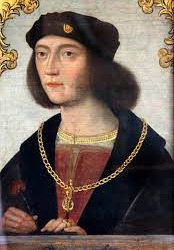
It is also suggested that portrait of James IV in inventary of Henry VIII was also made by Wewyck in between 1502-1503. But few portraits of James survive and we have mostly just drawings or engravings of them.
Do we have any clue how those lost Scottish paintings looked like? Maybe.
It’s likely that sketch of Margaret Tudor in Receuil d'Arras, a collection of portraits copied by Jacques de Boucq, done cca 1570, is based upon one of the two paintings of Margaret by Meynnart Wewyck:

(And yes, this commonly mislabelled as drawn from life)
The same collection of drawings also consist sketch of James IV(on left) and of his son Alexander Steward(on right)- Both could have been done by Wewyck. If those are who the text beneath drawing says they are.

Later, in March 1505 Henry VII paid Mennart Wewyck £1 for pictures(paintings).
(we don’t know which, if it was for past work or for future work. For example painter Sittow was not paid for works commissioned by Queen Isabella of Castile many years after she died.)
Wewyck also made 2 portraits of lady Margaret Beaufort.
1st was comissioned in 1506-presumably from life, 2nd posthumous was comissioned around 1510(that is our number 1).
He also made drawings/sketches then used by sculptor Pietro Torrigiano who made lady Margaret’s tomb.
But even though he was on royal payroll still in 1525(then he presumably died), as far as I know, we don’t know about which other paintings he made in between 1510-1525.
(Perhaps somebody can recommend a source which would give us a clue.)
Let’s look at his proven work again:
1)Posthumous portrait of Lady Margaret Beaufort, the Master's Lodge, St John’s College, Cambridge(UK):

It’s huge! (no wonder it was refered to as a table) And sadly the painting doesn’t look exactly as it used to when it was made. It suffered localised paint loss, particularly in the lower-left corner, and is also partly obscured by discoloured varnish and retouchings. Further more, the face when being made was bit off, and painter moved it about an inch(this happens a lot, sometimes you sketch it all-come to get snack and return and realise it is iffy!) Normally, you’d not see that painter did this. But sadly, due to thinning of layers you can. You see lady Margaret’s nose twice.
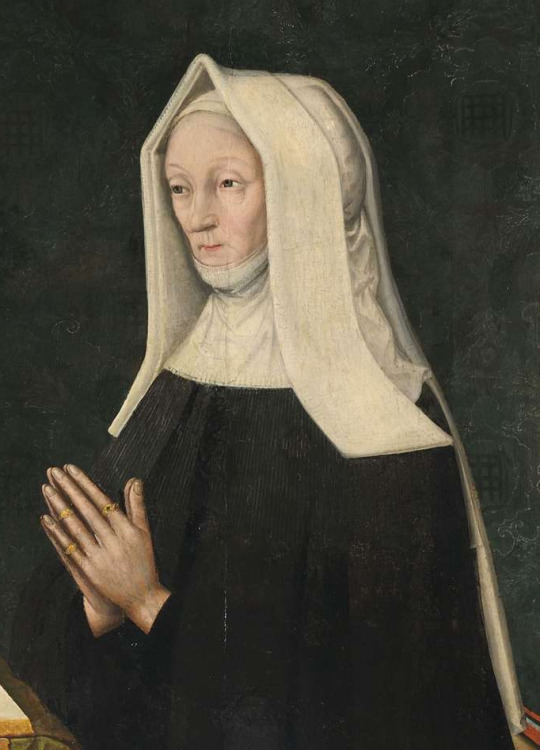
So if you wish to know how originally those parts of painting looked like, I recommend looking at a copy by Rowland Lockey, commissioned in 1598 (it’s also in St. John’s Colledge, University of Cambridge):
it’s really great copy(unlike so many copies of Tudor paintings)
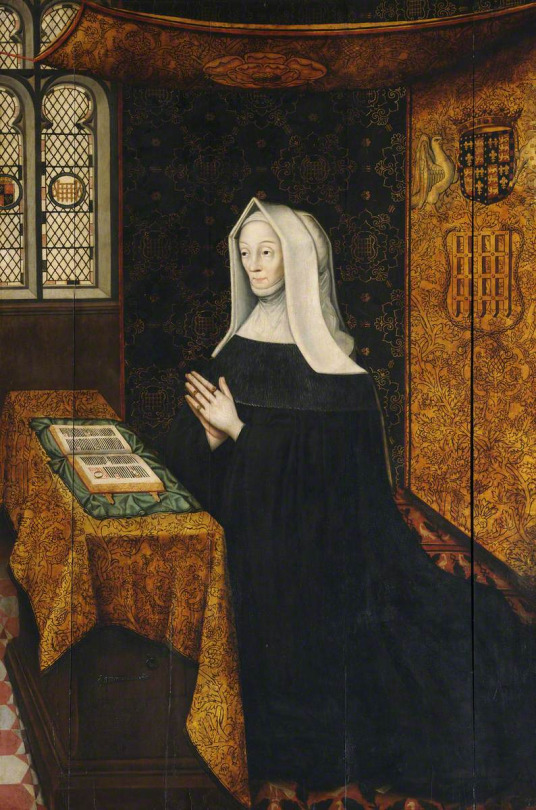
2)Portrait of Henry VII in Society of Antiquaries of London:Burlighton House(UK):

3)Portrait of Henry VIII, Denver Art Museum(USA):

4)Potrait of Henry VIII Anglesey Abbey(National Trust Collection), (UK):

Once again, this is actually not the original portrait. Beneath the layers of the paint is another portrait of Henry VIII(or at least it seems like him to me)
Sadly I am still searching for bigger picture which would show the painting beneath it.
5)Portrait of Henry VIII , Private collection:
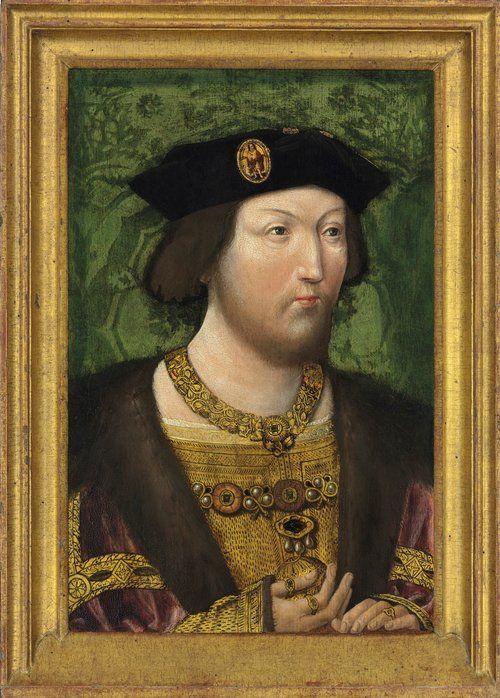
6)Portrait of Henry VIII, Private collection:


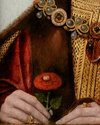
As for Elizabeth of York, they were looking at these two portraits of her:
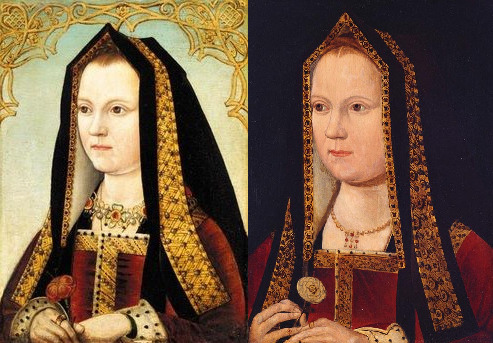
Queen Elizabeth of York, about 1470–98. Royal Collection Trust, Haunted Gallery, Hampton Court Palace( UK):
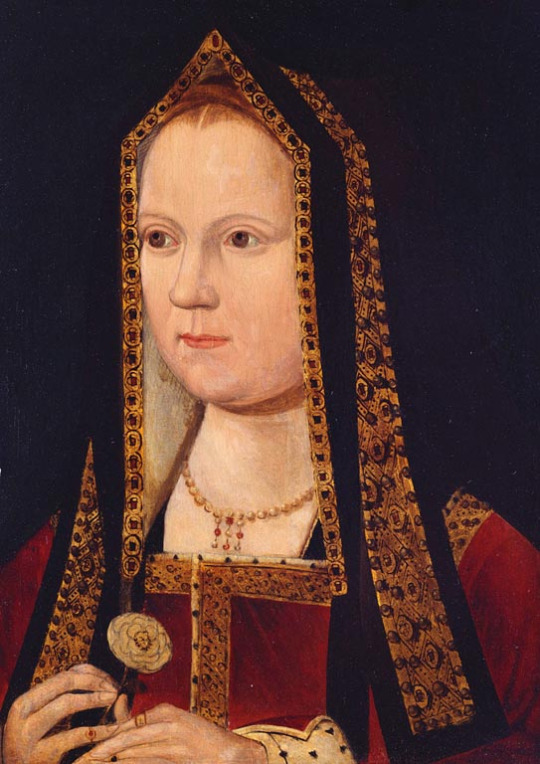
38.7 cm x 27.8 cm

Queen Elizabeth of York, about 1500(supposedly). Bryan Collection, Crab Tree(supposedly- I couldn’t find it):

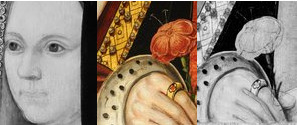
And imo they are not drawn from life. But are very early copies. Very early indeed. Maybe even 1510s or 1520s. Because they have turned frontlets-just as on her tomb. Due to fabric upon hood being black(only paste is white), this details is so hard to spot-that it is unlikely it could have been copied when artist no longer knew how it was supposed to look like.
But what exactly made them believe in first place that these might be by same artist/same workshop? The artistic similiarities-are kind of vague term. Sadly, I couldn’t find what exactly they mean. It’s not written down in April 2019 article, and as I said nor could I find detailed report about the fallowing research. Just tidbits
However, if you just look at those paintings in HD(or at good photos), even as amateur you can spot some the similiarities. So which are they? Imo:
1)the fur
number 2(on left) and number (3)-shading of it suggests same hand

Problem is, different kinds of fur would require different shading and hence it could be hard to spot.
2)the cloth of gold pattern. You might think King could have cloth of with this pattern-and be painted by several different artists-and they’ve still end up same. Not entirely true.

Idk if you ever attended drawing lessons. I have and one of the exercises we were to do-was to draw picture of certain actor based upon his photography. And each person’s same actor-came out completely different.
Of course trained painter, with good eye, might be able to do very good copy, and few even copy as good as the original. But usually that is not the case.
Each person does it bit differently even if they try not to. So it should be recognizeable feature. But it is isn’t in many cases-because they weren’t just painting the area. In most cases these painting were gilded. And sometimes re-gilded later on.
And way too often the re-gilding was done poorly, destroying the original pattern beneath and skill of previous artists hence doesn’t show. Details are often gilded over!

I am 90% sure that brooch(above) on Henry VII’s hat on number 2 is same as on multiple painting(including number 6), all of which have it with red stone:


On Henry VIII, which grew to bigger than his father, it looks tiny! But it’s very likely same brooch.
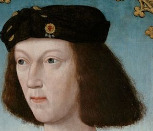
Also, rather often silver or golden gilding comes off(that is why so often it gets re-gilded), revealing just the basic under layer made in beige or yellowish colour.
And only traces of gold(which in same cases disappeared completely) are later found during proffesional exhaminations.
Why not every painting has issues like that? Due to different conditions painting is kept in=(enviroment vs glue), and due to different people taking care of them.
3)thinning of layers
Not all paintings must have this necessarly(different envirement might or might not make this occur). But certain painters’ work tend to to have the same issues more often. It might not be so obvious all the time as with potrait of lady Margaret. But number 5 has lines under eyes and sketches of brows which shouldn’t be visible.

So thinning of layer might suggest it is same artist. But also it can also mean master and apprentice, or same workshop. It’s definitely no proof by itself.
4)the fabric-how it is painted. In most of these recognizably it is crimson velvet. And while one time(number 5) it doesn’t have the vivid colour(probably because somebody else made the mixed the pigments), the style of this velvet is same or very similar. It could be same workshop, in several cases even same painter.
(I think it is possible that some people within workshop specialized in painting just 1 part of portrait-just fur, just velvet, just golden details, just the face. While in non-royal commissions(or not high status) perhaps 1 painter would be allowed to do even entire painting, I think for the high status, they’d really combine their skills for the best result.)
5)The other details-pearls, jewelry, hair, flowers etc.
Each of these can be as big as clue, as any of the much larger things.
Here very notable are the roses on number 2 and 3(again):

-that is by same hand for sure
if you look at neck of men in 2 and 3, you can also notice the same v-like shape.

That imo is not just painter’s skill showing-but hereditary feature between father and son(a detail which copies usually don’t bother to copy). Imo it’s this:

According to anatomy sketches on google-in that area should be jagular notch(the dip) between clavicles(which are to the sides and not forming that v) and then sternal head( sternocleidomastoid muscle).
So if the outfit allows you to see young Henry VIII’s neck in full, it might be there.
But number 5 already doesn’t have even hint of it and overall the visible differenes between the two are big. Yet experts say it is same by Wewyck(or his workshop):
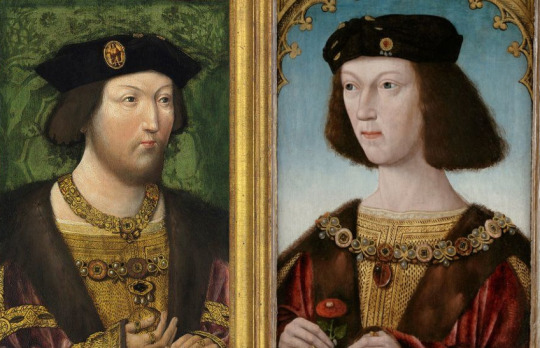
And imo it’s indeed possible. The jewelry and gilded patterns are done in same way. The velvet too-but clearly somebody new mixed the pigment for the crimson-and it eventually faded away, and didn’t stay vivid as in other paintings.
But it’s just same workshop in different time.(and that is why you need experts to have look at those paintings and say-yeah this was also crimson, the drawing beneath is done in same way, etc. etc.)
Another detail are the male hats-often done in black, which hides the details actually), the type and size of hat can be helpful in dating the piece.
But rather often somebody tried to ‘correct’ the hat. It’s one of the most altered things on male portraits(imo). Very likely these portraits originally(3,6) showed same type of hat:
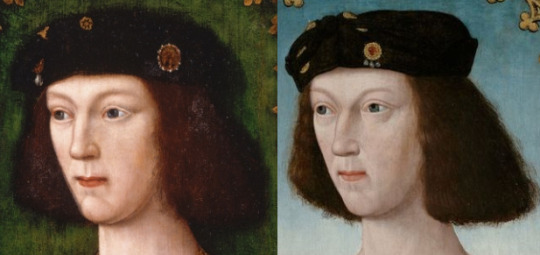
their hands also are folded in alost exact same way, and they sit same way.

Different roses suggest some time passed between their paintings, and noses do too(yes, in one he could be teen and in other adult), but their philtrum(that part above lip under nose), the chin, very likely at least sketched by same original painter, if the skin was not done by him too.
6)background
By now we know that very early work by Meynnart Wewyck(’s workshop) originally had blue background-very likely like this-blue fading into white, in lower part:
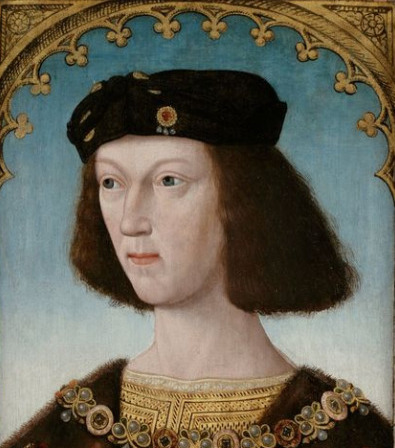
It reminds me of blue sky on nice summer day. Recently we had a lot of such days near my home, and especially when seeing the fields with grain growing and harvest aproching, several times I had thought-ideal day for grain harvest.
And in Tudor times, grain was staple of the diet, and good weather throughout the year and for the harvest would be crucial. So imo this kind of background symbolizes prosperity, good days, brought by the Tudor dynasty.
And the golden details at top of painting are also part of that background. But such background on its own is not enough of proof, it just helps to date the painting-because at certain times such background was popular and later it was not. Same goes with damask background. Such fabrics could spread around Europe and appear in paintings by multiple workshops. By its own, they are not a proof of same workshop. In Netherlands that’d be impossible to tell which imo. But in England, where there weren’t that many painters, it could help. If nothing else to pinpoint aproximate date when fabric with this pattern was fashionable(based upon other paintings featuring it elsewhere in Europe).
So imo both types of these backgrounds can actually be interesting detail to look out for.

However when it comes to damask backrgound, since most don’t survive in original nor good condition, finding two paintings with exact match can be extremely difficult. But not impossible.
But what I’d recommend against using as conclusive proof-is the skin.
Certain aspects of it such as thinning of it and shading, yes you can use that. But I know for sure that paintings of same person even if painted in exact same time by 1 same artist, if kept in different conditions/different envirement-the skin can look drastically different. Really different. Skin is not realiable proof, ok?
So can we find based upon these details more work of Meynnart Wewyck’s workshop? Well, not conclusively, we cannot prove it! Because the expert analysis and exhamination of the paintings would be also necessarly.
But we can find some where we see the same details as which I just listed above. So in part 2 I’ll show you some of those and my other picks for ‘possibly by Wewyck’s workshop’ and reasons why I believe experts should take look at them.
I hope you’ve enjoyed it.
#long post#historical portraits#meynnart wewyck#tudors#Lady Margaret Beaufort#henry viii#henry vii#henry vii of england#elizabeth of york
38 notes
·
View notes
Note
AU - Margert Beaufort's plans succeeded when she learns her son Henry seduced and eloped with King's sister Lizze, but as she reviced letter from her son shocked her , that Henry admit that he and Lizzie really love each other
Hello! I'm not sure if anon simply wanted me to give my thoughts on this AU but here's a little snippet I ventured to write after thinking about it. We start here from the premise that Edward V survives and defeats his uncle in this scenario. Under the cut!
When the messenger found Margaret at last, the sun was only then starting to peak on the horizon, a shock of white light haloing in the dark blue expanse pooled on the back of St Paul's highest spiral. She opened the sealed missive carefully, with increasingly tremulous fingers, kneeling at the priedieu before the carved altar niche in her chamber. Her breath held deep in her chest, she sent a prayer to the Virgin to give her the necessary fortitude to bear what news they had sent her. She was confronted with her own dear son’s handwriting.
Madam, my most entirely well-beloved lady and mother, in as humble manner as I can think, I recommend me to you, beseeching you that I may explain to you my mind and sincere enterprise before any others, bitterly vexed that a report should have been made to you before this my own letter, calculated to diminish the great genuine and motherly love you have always borne me above all others, as I know for a certainty. And I thought I should not offend you, which I will never do willfully, to advertise unto you that it is my heart’s desire and intent to take the Lady Elizabeth the king's sister to wife, and that for this my said enterprise we make passage onto Calais, trusting Almighty God to give us safe and speedy shelter in those parts. Desiring therefore not to encumber you, but that I would make some recompensation for your displeasure with my writing, in my hearty wise I declare unto you that the lady has made her long and grievous suit to me, tears flowing on her face, humbly imploring me that I should deliver her of her fate and tragedy to be sent into the parts of Bourgogne to be wed to Maximilian the Archduke of Austria, according to the king’s disposition, as my lady well knoweth. And, finding my heart not less well-disposed towards hers than hers towards mine, I am decided to follow it as much as God will give me grace, as the only woman I have chosen to take as my lawfully wedded wife, under the leave of the Holy Father and the Church’s full blessed sacrament, if the Pope will be so kind as to grant us the dispensation in good time.
Margaret paused, drowning at a dark and despairing loss for words. She would never have predicted that sudden turn of events. Her son, enamoured with the king’s sister! Who could tell? Margaret had only seen the long glances the young lady, England’s beloved Bessy, had bestowed on Henry upon his return to the country, but she had deemed them but a young girl’s passing curiosity towards a stranger and former exile—a fascination with the unknown, and nothing more. Having aided the king in his just cause against his uncle, Margaret would never have thought her son could so soon turn against the young sovereign’s wishes by eloping with his sister. The picture was grim.
Verily, madam, the lady is good and virtuous, a peerless gentle and wise maiden of the highest degree, so chaste and beautiful to behold it fully caused my heart to ache without her sweetest presence by my side, so that I have not wished to see or hear any other human presence since I first laid my eyes upon her fair face, for I love her with soul and body, and trust our Lord to never make us part in this life or beyond. Therefore I truly wanted to tell you, madam, if I be too bold in this enterprise, or any my desires, I humbly beseech you of your pardon, knowing well how great and unremitting have been your benevolent and watchful efforts for my advancement, so much it were difficult to express. Wherefore I pray you will make suit into my lady’s mother the queen for the great and singular friendship it has pleased her at all times to bestow upon you, to plead for our cause next to her son the king, and that we may know her mind and pleasure on our behalf. And if I should never have the king’s nor the queen’s blessing, my mother, yet your kind dealing is to me a thousand times more than all the favour that can be dispensed on my cause. I thank you most heartily, wishing God to ever preserve you in good health and long life.
Accept the writing I send, and have of me all the faith and devotion there is.
By your humble son and loyal friend,
H Richmond
Margaret folded the letter and pressed it against her heart for a long moment. If King Edward were still alive, her son’s eloping with his eldest daughter would be nothing short of treason. Now that Elizabeth was but the king’s sister, however... there was perhaps a sliver of hope, though she dared not yet to grasp it. Catastrophe and fortune hung in the air, suspended as a some great bell about to ring. Margaret wanted to stay and pray for her son but there was no time. She needed to act, and act she would.
“Joan,” she spoke to the damsel in her room, “Send for the carriage at once.”
#can't believe i actually wrote this lol#anyways enjoy ♥#henry vii#elizabeth of york#ask#anon#AU#henry vii x elizabeth of york
26 notes
·
View notes
Text
Events 1.18 (before 1970)
474 – Seven-year-old Leo II succeeds his maternal grandfather Leo I as Byzantine emperor. He dies ten months later.
532 – Nika riots in Constantinople fail.
1126 – Emperor Huizong abdicates the Chinese throne in favour of his son Emperor Qinzong.
1486 – King Henry VII of England marries Elizabeth of York, daughter of Edward IV, uniting the House of Lancaster and the House of York.
1562 – Pope Pius IV reopens the Council of Trent for its third and final session.
1586 – The magnitude 7.9 Tenshō earthquake strikes Honshu, Japan, killing 8,000 people and triggering a tsunami.
1670 – Henry Morgan captures Panama.
1701 – Frederick I crowns himself King in Prussia in Königsberg.
1778 – James Cook is the first known European to discover the Hawaiian Islands, which he names the "Sandwich Islands".
1788 – The first elements of the First Fleet carrying 736 convicts from Great Britain to Australia arrive at Botany Bay.
1806 – Jan Willem Janssens surrenders the Dutch Cape Colony to the British.
1866 – Wesley College is established in Melbourne, Australia.
1871 – Wilhelm I of Germany is proclaimed Kaiser Wilhelm in the Hall of Mirrors of the Palace of Versailles (France) towards the end of the Franco-Prussian War. Wilhelm already had the title of German Emperor since the constitution of 1 January 1871, but he had hesitated to accept the title.
1886 – Modern field hockey is born with the formation of The Hockey Association in England.
1896 – An X-ray generating machine is exhibited for the first time by H. L. Smith.
1911 – Eugene B. Ely lands on the deck of the USS Pennsylvania anchored in San Francisco Bay, the first time an aircraft landed on a ship.
1913 – First Balkan War: A Greek flotilla defeats the Ottoman Navy in the Naval Battle of Lemnos, securing the islands of the Northern Aegean Sea for Greece.
1915 – Japan issues the "Twenty-One Demands" to the Republic of China in a bid to increase its power in East Asia.
1919 – World War I: The Paris Peace Conference opens in Versailles, France.
1919 – Ignacy Jan Paderewski becomes Prime Minister of the newly independent Poland.
1941 – World War II: British troops launch a general counter-offensive against Italian East Africa.
1943 – Warsaw Ghetto Uprising: The first uprising of Jews in the Warsaw Ghetto.
1945 – World War II: Liberation of Kraków, Poland by the Red Army.
1958 – Willie O'Ree, the first Black Canadian National Hockey League player, makes his NHL debut with the Boston Bruins.
1960 – Capital Airlines Flight 20 crashes into a farm in Charles City County, Virginia, killing all 50 aboard, the third fatal Capital Airlines crash in as many years.
1967 – Albert DeSalvo, the "Boston Strangler", is convicted of numerous crimes and is sentenced to life imprisonment.
1969 – United Airlines Flight 266 crashes into Santa Monica Bay killing all 32 passengers and six crew members.
1 note
·
View note
Photo







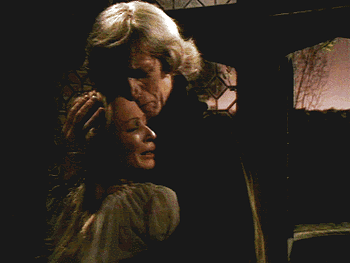
Gifset request meme: from @allegoriesinmediasres -> The Shadow of the Tower + 16 (most heart-breaking scene - Arthur’s death in 13. “The King Without a Face.”)
“Oh, my sweet Arthur! My darling boy! I cannot think that he is no more with us. We shall never look on him again. I cannot think it! He was so fair.” // “What shall I say to comfort you who gave me such comfort? Only your own words, your own counsel.”
#the shadow of the tower#gif#gifset request meme#henry vii#elizabeth of york#henry vii x elizabeth of york#james maxwell#norma west#1970s#period drama#quotes#my gifs#allegoriesinmediasres#there are three really sad bits just in this episode#it's hard to choose but probably this#especially because it's essentially what they were really reported as saying#hugs#death#crying
78 notes
·
View notes
Text

modern au tudor aesthetics: henry vii & elizabeth of york
#wanted to try something#i have a whole pinterest board tbh#also using my julie delpy and ethan hawke fancast ehehe <3#modern au#modern aesthetic#modern edit#modern#historical figure aesthetic#edit#historical edit#history aesthetic#aesthetic#perioddramaedit#*my edits#elizabeth of york#henry vii#ethan hawke#julie delpy#henry x lizzie#otp: the welsh dragon and the white rose#picspam#tudor au#the tudors#au moodboard
35 notes
·
View notes
Note
scenario KIng henry Vii decided to make Henry viii Crown Prince of England can you please do Mistress reader, Elizabeth of York and Prince Arthur react to this?
Elizabeth had never thought that the King would do such a thing. She feels so angry and betrayed. She will try to change the king's decision. She will even plan the assassination of Prince Henry (8). She will look for ways to get rid of the prince.
Arthur feels offended and betrayed. He will be very jealous of his stepbrother. He will try to change his father's decision. He will feel insecure about himself.
#yandere king henry vii x reader#yandere king henry vii#yandere tudors characters#yandere the tudors#yandere tudors#house of tudor#the tudors#yandere the white princess#elizabeth of york#king henry viii
25 notes
·
View notes
Text
Westminster Abbey and the creation of the Tudor Rose 🌹🏵️
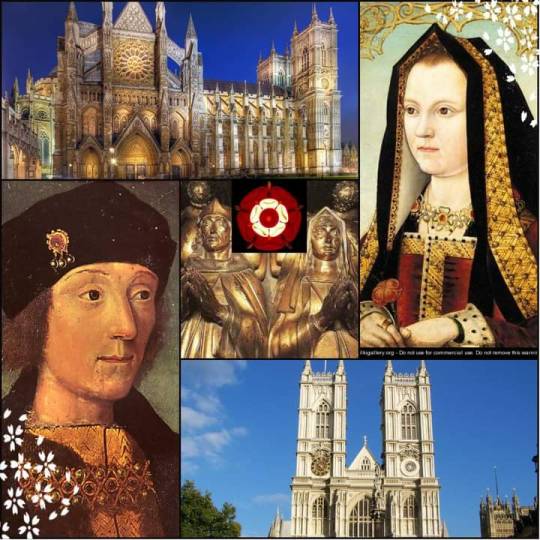
“Westminster Abbey is home to 1,000 years of royal history. Edward the Confessor first founded an Anglo-Saxon abbey here in 960, and the present abbey dates from 1245 when it was built by Henry III to house Edward the Confessor’s shrine. The pointed arches, flying buttresses and rose windows are typical of the French-inspired Gothic style that was fashionable in thirteenth century architecture, and nearly every addition to the Abbey since –including the eighteenth-century West Towers by Nicholas Hawksmoor- have copied the thirteenth-century original. The one exception is the beautiful sixteenth-century fan-vaulted Lady Chapel in the east end of the Abbey behind the High Altar, which was built by Henry VII after the death of his beloved wife, Elizabeth of York, in 1502. He, too, was subsequently buried here.
Henry VII chose Westminster Abbey as his wife’s resting place because the couple had solemnized their momentous union here on 18 January 1486. (This was the last royal wedding at Westminster Abbey until 1919, when the Abbey was readopted by the modern royals with the Princes Pat’s –one of Queen Victoria’s granddaughters- nuptials). The marriage between the nineteen year old Elizabeth and the recently crowned King Henry VII was cause for celebration indeed. It marked the coming together of the warring houses of York and Lancaster: an end to the bloody Wars of the Roses that had torn England apart on and off for over thirty years. A strikingly attractive and intelligent woman, with long golden hair, Elizabeth wore her finest robes for the wedding –described as glowing ‘with gold and purple dye’- and a necklace ‘framed in fretted gold.’ She carried symbolic white and red roses.
As with HRH Prince William and Catherine Middleton’s wedding in April 2011, Henry and Elizabeth’s nuptials were marked by festivities and street parties. Accounts say that the wedding was ‘celebrated with all religious and glorious magnificence at court and by their people with bonfires.’”
- A Journey Through Tudor England by Suzannah Lipscomb
The red rose of Lancaster as Henry made it known had never been the official symbol of the Lancastrian dynasty, nor the white had been the only symbol the York dynasty for that matter. The former had many sigils, the red rose started to be used by the commons supporting the Lancastrians after Edward, Earl of March had taken the white rose as one of his official sigils. His brother, the last Yorkist King used the white boar. Furthermore, there was a religious symbolism to the latter that preceded the Yorkist house.
"The simple five-petal design of the heraldic rose was inspired by the wild dog rose that grows in the English hedgerows. As a symbol it had a long associated with the Virgin Mary, who is sometimes called the Mystical Rose of Heaven. But Henry IV had once used red roses to decorate his pavilion at a joust, their use as a Lancastrian royal badge was not widespread before the advent of the Tudors."
- Tudor. Passion. Murder. Manipulation by Leanda de Lisle.
There were occasions when the Lancastrians used the white rose too because of its religious symbolism. They stopped using it after Edward IV was crowned and he made it one of his primary badges (along with the sun in splendor).
Henry VII however, made it appear this way to create a new and powerful symbol that told the people that the dynastic wars that had plagued England for more than thirty years were over and that there was finally peace in the realm.
#henry vii#henry vii x elizabeth of york#elizabeth of york#wars of the roses#lancaster#York#Tudor Rose#history#dailytudors#westminster abbey
60 notes
·
View notes